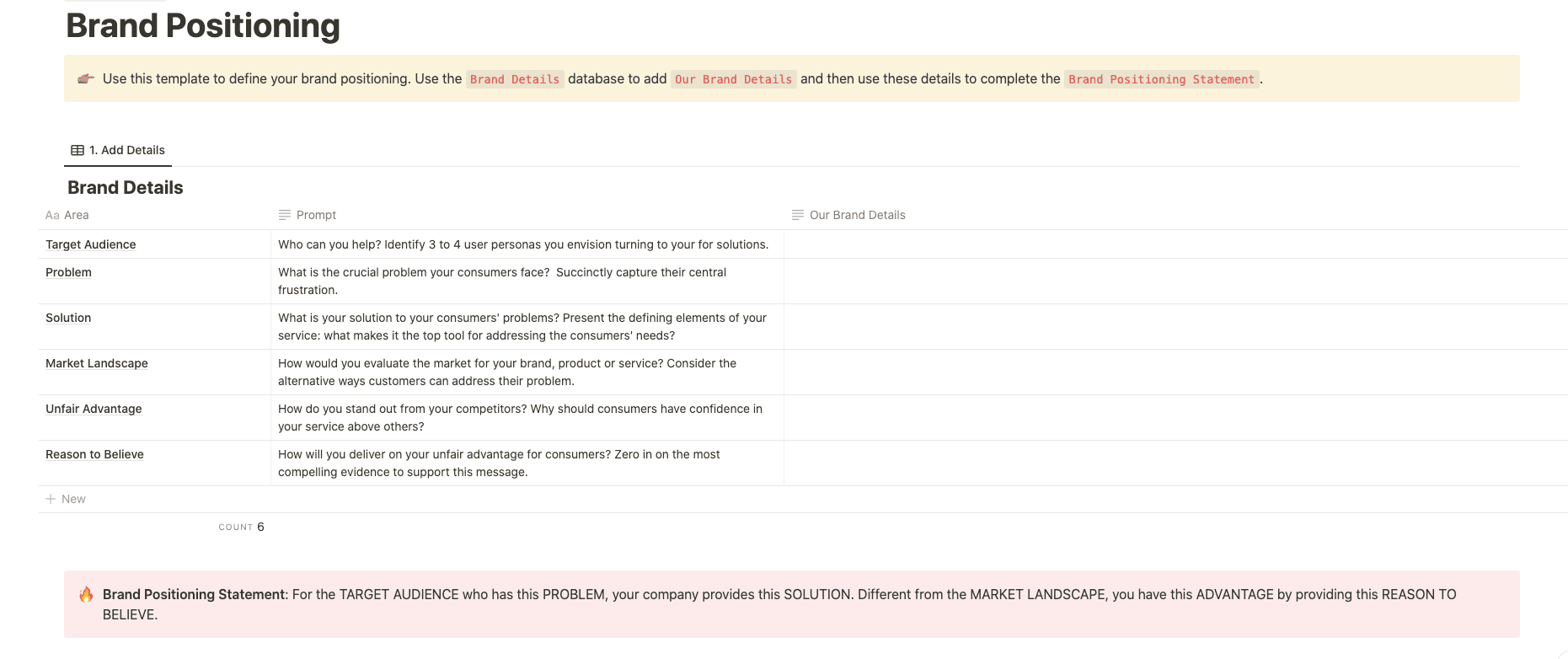Use this template to define your brand positioning.
Buy on
Contents
Notion – Brand Positioning Template
Use this template to define your brand positioning. Market positioning is an essential step of the planning process — either when you start a business or when you expand to a new market. It defines:
- Where your brand fits in the marketplace
- How your brand compares to competitors
- The brand attributes and benefits you want to be associated with
- The company beliefs, attitudes, and principles that support all the interactions a customer has with your brand — the Complete Product Experience (CPE)
Doing this positioning work as part of strategic planning sharpens your focus on the differentiating factors that set your brand apart. It can be used to guide product and marketing decisions — each decision you make along the customer’s journey should be consistent with how you have defined the brand.
What you need before purchase
- Basic knowledge of how to use Notion
- Paid Notion account if you’re looking to add lots of content to your template / Notion account (sign up here). Not much content? You’re able to use their free account.
After purchase, you’ll be able to view the template immediately. The template can be added to your Notion account by:
- Click on the template download link in Gumroad
- When viewing the Notion template, click on the “Duplicate” link in the top-right of your screen
- The template will now be available in your own Notion account
What is a Brand Positioning Template?
A Brand Positioning Template is a framework or tool used by businesses to define and articulate their brand positioning strategy. It provides a structured format to identify and communicate the unique value proposition of a brand and how it differentiates itself from competitors in the market.
A brand positioning template typically includes key elements that help shape the brand’s identity and positioning. While templates may vary, here are some common components found in a brand positioning template:
- Target Audience: Clearly defines the specific audience or market segment the brand aims to target. This includes demographics, psychographics, and other relevant characteristics of the ideal customer.
- Brand Essence: Expresses the core essence or fundamental nature of the brand. It captures the brand’s personality, values, and the emotional or rational benefits it delivers to customers.
- Unique Selling Proposition (USP): Identifies the key differentiators that set the brand apart from competitors. It highlights the distinct features, benefits, or attributes that make the brand stand out in the market.
- Competitive Analysis: Evaluates the competitive landscape by analyzing the strengths, weaknesses, and positioning strategies of competitors. This helps to identify opportunities for differentiation and positioning.
- Brand Promise: Articulates the specific promise or value proposition that the brand makes to its target audience. It communicates the unique benefits and solutions the brand offers to fulfil customer needs or desires.
- Brand Positioning Statement: Summarizes the brand’s positioning strategy in a concise and impactful statement. It often includes the target audience, unique value proposition, and key brand attributes in a memorable way.
- Messaging and Communication Guidelines: Outlines the key messages, tone of voice, and communication guidelines that align with the brand positioning. It helps ensure consistent and cohesive messaging across all brand touchpoints.
- Brand Visual Identity: Includes guidelines for visual elements such as logo usage, typography, colour palette, imagery, and other design elements that visually represent the brand.
A brand positioning template serves as a guide for internal stakeholders and external partners to understand and communicate the brand’s positioning consistently. It helps establish a clear and compelling brand identity in the minds of customers, supporting effective marketing and communication efforts.
How do I create a Brand Positioning Template in Notion?
To create a Brand Positioning Template in Notion, you can follow these steps:
- Open Notion: Log in to your Notion account or create a new one if you don’t have an account already.
- Create a New Page: Click on the “+” button in your workspace to create a new page.
- Choose a Template Type: Select the “Templates” option from the sidebar on the left.
- Browse or Search Templates: In the Templates section, you can browse through the available templates or use the search bar to find a suitable template. Look for templates related to branding, marketing, or strategy.
- Select a Template: Choose a template that closely aligns with your requirements for a Brand Positioning Template. Look for templates that include sections for target audience, brand essence, unique selling proposition, brand promise, and competitive analysis.
- Customize the Template: Once you’ve selected a template, you can start customizing it according to your brand’s unique positioning strategy. Edit the sections, headings, and content to align with your brand’s attributes, target audience, and competitive landscape.
- Add Relevant Sections: Ensure that your template includes sections that cover the essential components of a brand positioning strategy, such as target audience, brand essence, unique selling proposition, brand promise, competitive analysis, and messaging guidelines. You can add, delete, or modify sections as needed.
- Format and Structure: Utilize Notion’s formatting options to structure your template effectively. Use headings, subheadings, bullet points, and other formatting features to make the template organized and visually appealing.
- Save as a Template: Once you have customized the template to your satisfaction, save it as a template in your workspace for future use. Click on the three-dot menu at the top right corner of the page and select “Save as Template.”
- Name and Describe the Template: Give your template a descriptive name that reflects its purpose, such as “Brand Positioning Template.” Add a brief description or instructions to help others understand how to use the template effectively.
Now you have created a Brand Positioning Template in Notion that you can use as a starting point for developing and documenting brand positioning strategies. You can duplicate the template whenever you need to create a new brand positioning document and modify it to fit the specific needs and characteristics of each brand.














